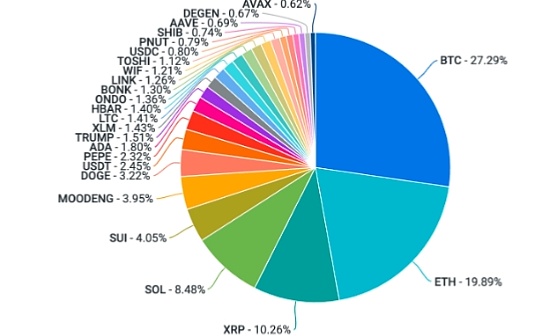1 BTC= 100 million bitcoin? What exactly is the hotly discussed BIP 177?

Reprinted from chaincatcher
05/19/2025·20DAuthor: KarenZ, Foresight News
In the Bitcoin ecosystem, the BIP 177 proposal is triggering a discussion about the unit of Bitcoin’s accounting, how it is displayed, and the nature of user experience. This improvement proposal attempts to fundamentally reconstruct the way we perceive and use Bitcoin.
In addition, Satoshi Nakamoto also mentioned in the early days that if Bitcoin experiences large-scale deflation in the future, the software may display more decimal places. BIP 177 echoes this idea.
What is BIP 177?
BIP 177 (Bitcoin Improvement Proposal 177) is an improvement proposal for Bitcoin, aiming to redefine the accounting unit and how Bitcoin is displayed. The core concept of IP 177 is to eliminate decimal display to make the amount of Bitcoin more intuitive and easy to understand, thereby lowering the threshold for new users and promoting the popularization of Bitcoin in daily payments.
The related proposal was first proposed by Bitcoin enthusiast and Synonym CEO John Carvalho (@BitcoinErrorLog) on December 10, 2024. At the time, it was hosted in the BitcoinAndLightningLayerSpecs/balls repository on GitHub, and the BIP number has not been assigned. On May 8, the draft proposal of BIP 177 was officially merged and added to the Bitcoin BIP list. At present, BIP-0177 is still in the draft stage and has not been officially adopted yet, and community discussions are underway.
Specifically, BIP 177 proposes to redefine the minimum indivisible unit of Bitcoin (1 BTC = 100,000,000 basic unit) as "1 bitcoin", thus making the current 1 BTC equal to 100 million new "bitcoin". This change only involves the way UI is displayed and will not cause any substantial changes to Bitcoin (BTC) consensus rules, the total amount limit of 21 million, or the underlying logic of the blockchain ledger.
BIP 177 What is the purpose of the proposal?
The main purpose of BIP 177 is to simplify the user experience of Bitcoin and solve the confusion caused by the current unit display method.
- Eliminate complexity from decimal points: The current price of Bitcoin is usually displayed in BTC. Small transactions (such as buying a cup of coffee) may involve numbers like 0.0001 BTC, with eight decimal places confusing new users. BIP 177 proposes to use the minimum indivisible unit as the base unit to display the amount as an integer (such as 100 bitcoin instead of 0.000001 BTC), which is more in line with the intuition of daily currency use.
- Educational Value: Newcomers can directly understand that Bitcoin is a discrete unit, rather than a "dividable decimal currency".
- Lower the entry threshold for new users: Many people are not familiar with the term "cong" and find it difficult to understand the conversion relationship of 1 BTC = 1 Econg. By redefining "bitcoin" as the smallest unit, BIP 177 hopes to make it easier for ordinary users to understand and accept Bitcoin, especially in the context of high prices.
What are the pros and cons of BIP 177?
Potential Advantages
- Simplify user experience: Displaying amounts in integers (such as 100 bitcoin instead of 0.000001 BTC) is more intuitive, reducing the confusion caused by new users due to decimal points.
- Promote the daily use of Bitcoin: By making small transactions easier to understand, BIP 177 is expected to promote the application of Bitcoin in the field of micro payments and enhance its practicality as a currency. This can also inspire more merchants to accept Bitcoin and form a circular economy.
- Consistent with protocol logic: The proposal makes the UI display integer operation methods closer to the Bitcoin protocol, reducing the complexity of artificial agreements and improving technical transparency.
- Low Risk Adjustment: BIP 177 does not involve consensus rule changes, no hard forks or upgrades to miner nodes, only wallets and exchanges need to adjust the UI. This means that implementation costs are lower and risk is less.
- Expanding the user base: By lowering psychological and cognitive thresholds, BIP 177 may attract more ordinary users to the Bitcoin ecosystem, especially in developing countries or groups that are not familiar with cryptocurrencies.
Potential disadvantages and challenges
- Challenge of community acceptance: The Bitcoin community's perception of "Bitcoin" as a standard unit is deeply rooted, and changing the unit name may cause controversy. Some users believe that "sats" is a community consensus, and redefining "bitcoin" may be regarded as unnecessary complications.
- Confusion in the transition period: In the early stages of BIP 177 implementation, different wallets and platforms may adopt different unit display methods (some use new bitcoin, while others continue to use BTC or sats), which may lead to user confusion and even malicious use.
- Cultural inertia: The popular "silent" culture and terms in communities may be affected.
- Limited practical impact: Some critics argue that changes displayed by units have limited effect on promoting Bitcoin popularity. The bottleneck of user experience may be more from transaction fees, confirmation time, or ease of use of the wallet than the unit name.
If passed, how will it be handled?
If the BIP 177 proposal adopts, the overall conversion rule is that the Bitcoin ledger and consensus rules remain unchanged. BTC remains the same as currency code. Implementation using the new standard must multiply the original bitcoin value by 100 million and convert it into an integer form. Specifically:
- Unit redefinition: The base unit remains unchanged. Originally 1 bitcoin = 100,000,000 basic unit; under the new definition, 1 bitcoin = 1 basic unit.
- Term changes: satoshi or sat (Sat) will be deprecated. All interfaces, documents and displays should directly refer to the basic unit as "bitcoin". "BTC" is not affected and still represents 100 million basic units.
- Display and format changes: The application should allow users to switch between traditional formats (1 BTC = 100 million base units) and new formats (1 bitcoin = 1 basic unit). The symbol "₿" can be used to represent the bitcoin of the base unit (₿ means that it is optional).
- For satoshi and sat: It has cultural value, but the official documents and interfaces should use "bitcoin" as the unique unit name.
The following examples are given in the BIP 177 draft proposal document:
- Old display: 0.00010000 bitcoin → New display: ₿10,000 or 10,000 bitcoins or 0.00010000 BTC
- Old display: 10.23486 bitcoin → New display: ₿1,023,486,000 or 1,023,486,000 bitcoins or 10.23486 BTC
- Old display: 0.345 BTC → New display: No changes required, or ₿34,500,000 or 34,500,000 bitcoins
For developers, if BIP 177 is adopted, the interface, API and documents need to be updated, the basic units are displayed in integers, and BTC is retained as large units. For users, the actual value of assets will not change. The application can help transition through dual displays, prompt tools, etc. (such as "0.0001 BTC = 10,000 Bitcoin" at the same time).
It is worth mentioning that for the "bits" (1 bit = 100 Satoshi) solution proposed by BIP 176, the proposer of BIP 177 believes that BIP 176 still relies on decimal thinking and requires users to switch units, which has not resolved the contradiction between the nature of the protocol integer and the display of decimals. By contrast, BIP 177's integer scheme is more thorough and once and for all.
summary
BIP 177 aims to facilitate the use of Bitcoin in daily transactions by redefining the basic units, simplifying the user experience. Its core advantages are lowering the threshold for new users, being close to protocol logic, and promoting the popularization of micro payments, while the main challenges are community acceptance, transitional chaos and education costs.
Therefore, the proposal of BIP 177 has sparked widespread discussion, with support and opposition voices coexisting. Supporters believe that BIP-177 can significantly improve the user experience of Bitcoin, especially in promoting micropayments and popular use. In addition, redefining the accounting unit and display method of Bitcoin can make users feel "having more bitcoin" and enhance their sense of participation. Jack Dorsey, a Twitter co-founder who has always advocated Bitcoin as a daily payment tool, also supports BIP 177 and shows that "Sharu" is an absolutely wrong term that prevents ordinary people from obtaining and consuming Bitcoin.
Opponents believe that BIP-177 may bring chaos, even damage Bitcoin’s consensus and market perception, and may make users mistakenly believe that supply volume is inflated and shake trust in Bitcoin’s scarcity.
It is worth mentioning that BIP-177 does not change the core economic parameters such as the total supply, issuance mechanism, transaction fees, etc., and only adjusts the display method, the direct impact on the BTC price is almost zero (the actual value held by the user will not change due to the unit redefinition). However, if BIP 177 is adopted, the unit price of 1 bitcoin will be reduced proportionally to 1/100,000 of the unit price of 1 BTC, but the actual value of the assets will not change. For example, if 1 BTC = $100,000, then under the new definition, 1 bitcoin = $0.001. The indirect impact of BIP-177 on BTC price depends on market sentiment and large-scale adoption of users. If user adoption and micro payment are promoted, indirect benefits may be increased through demand.
As a proposal that does not involve consensus changes, BIP 177's implementation is relatively simple, but its success depends on community consensus and the support of wallet developers. In the future, the Bitcoin community needs to weigh its pros and cons and decide whether to adopt it through public discussion. BIP 177 represents an important thought in the evolution of Bitcoin: how to optimize the user experience while maintaining the stability of the protocol. This discussion on "How Bitcoin should be understood and used by ordinary people" has gone beyond the technical level and touched on the core proposition of popularizing cryptocurrencies.


 jinse
jinse

